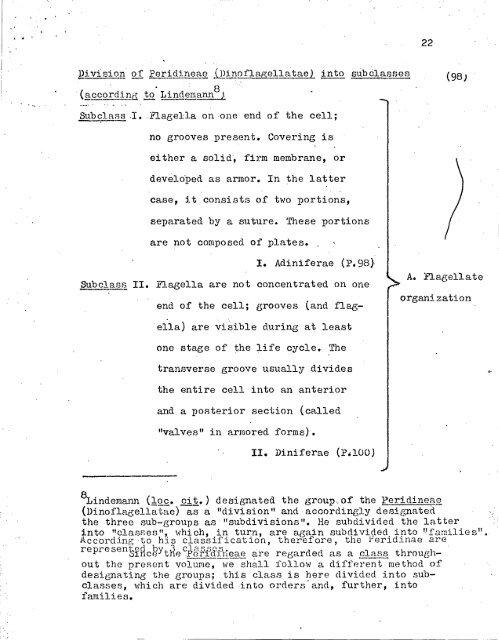Translation 2816
Translation 2816
Translation 2816
Create successful ePaper yourself
Turn your PDF publications into a flip-book with our unique Google optimized e-Paper software.
22<br />
Division' of Peridineae ipinoflagellatae), into subdlasses<br />
•<br />
(accordind to Lindemann 8<br />
(98)<br />
Subclass 1. .Flagella on one end of the cell;<br />
no grooves present. Covering is<br />
either a solid, firm membrane, or<br />
develobed as armor. In the latter<br />
case, it consists of two portions,<br />
separated by a suture. These portions<br />
are not composed of plates.<br />
I. Adiniferae (P.98 )<br />
Subclass II. Flagella are not concentrated on one<br />
A. Flagellate<br />
organization<br />
end of the cell; grooves (and flagella)<br />
are visible during at least<br />
one stage of the life cycle. The<br />
transverse groove usually divides<br />
the entire cell into an anterior<br />
and a posterior section (called<br />
"valves" in armored forms).<br />
• II. Diniferae (P:100)<br />
8 Lindemann (loc. cit.) designated the group,of the Peridineae<br />
as a "division" and'accordingly designated<br />
(Dinoflagellatae)<br />
the three sub-groups as - "subdivisions". He subdivided the latter<br />
1-nto "classes", which, in turn, are again subdivided into vfamilies".-<br />
According to his classification, therefore, the i'eridinae are<br />
represented by.3 classes,<br />
w.nce tne feriainpae are regarded as a class throughout<br />
the present volume, we shall follow a different method of .<br />
designating the groups; this class is here divided into subclasses,<br />
which are divided-into orders'and, further, into<br />
families.
















